

Compact Muon Solenoid
LHC, CERN
| CMS-PAS-HIN-16-015 | ||
| Measurement of ψ(2S) production in proton-lead and proton-proton collisions at √sNN= 5.02 TeV | ||
| CMS Collaboration | ||
| February 2017 | ||
| Abstract: This note reports the measurement of prompt ψ(2S) production in proton-lead (pPb) and proton-proton (pp) collisions at √sNN= 5.02 TeV. The results are based on pPb and pp data samples collected by CMS at the LHC corresponding to an integrated luminosity of 34.6 nb−1 and 28.0 pb−1 respectively. The nuclear modification factor, RpPb, is calculated for prompt ψ(2S) in the kinematic interval 4 <pT< 30 GeV/c and −2.4<yCM<1.93, and compared to the RpPb of prompt J/ψ. The RpPb of the excited state is found to be smaller than the RpPb of the ground state, over the whole kinematic range studied. The suppression is more pronounced in the region of negative rapidity and pT< 10 GeV/c. | ||
|
Links:
CDS record (PDF) ;
inSPIRE record ;
CADI line (restricted) ;
These preliminary results are superseded in this paper, PLB 790 (2019) 509. The superseded preliminary plots can be found here. |
||
| Figures | |

png pdf |
Figure 1:
(Left) Fit of the dimuon mass distribution both to the J/ψ and ψ(2S) peaks of the pPb data in the kinematical bin −2.4<yCM<−1.93 and 4 <pT< 6.5 GeV/c. The signal is fitted with Crystal Ball and Gaussian functions and background is described with a Chebyshev polynomial of degree 3. (Right) Fit of the dimuon mass distribution both to the J/ψ and ψ(2S) peaks of the pPb data in the kinematical bin 0 <yCM< 0.9 and 10 <pT< 30 GeV/c. The signal is fitted with Crystal Ball and Gaussian functions and background is described with a Chebyshev polynomial of degree 3. |
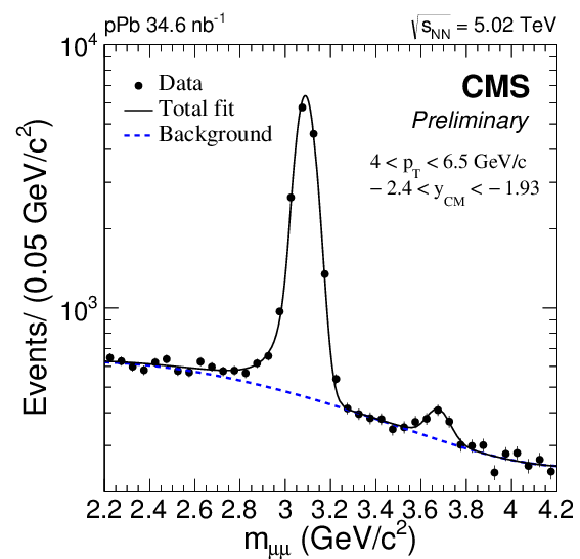
png pdf |
Figure 1-a:
Fit of the dimuon mass distribution both to the J/ψ and ψ(2S) peaks of the pPb data in the kinematical bin −2.4<yCM<−1.93 and 4 <pT< 6.5 GeV/c. The signal is fitted with Crystal Ball and Gaussian functions and background is described with a Chebyshev polynomial of degree 3. |
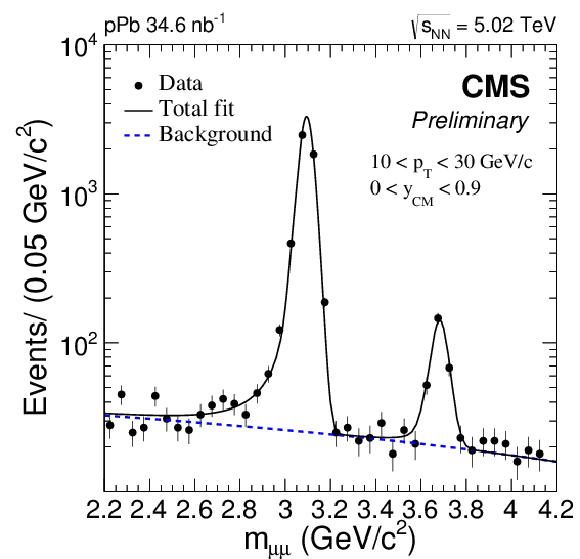
png pdf |
Figure 1-b:
Fit of the dimuon mass distribution both to the J/ψ and ψ(2S) peaks of the pPb data in the kinematical bin 0 <yCM< 0.9 and 10 <pT< 30 GeV/c. The signal is fitted with Crystal Ball and Gaussian functions and background is described with a Chebyshev polynomial of degree 3. |
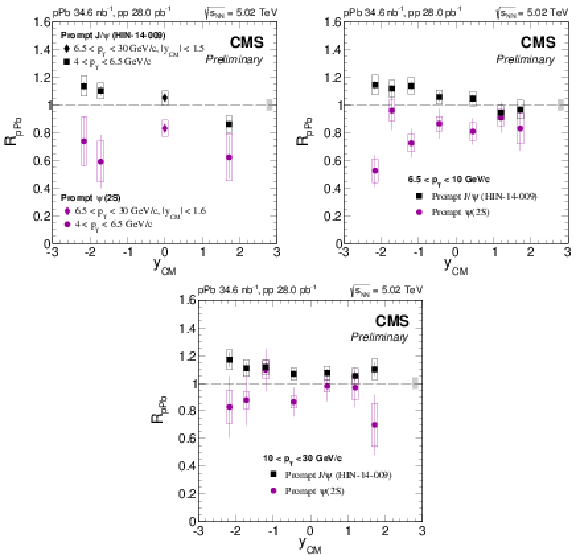
png pdf |
Figure 2:
Rapidity dependence of RpPb for prompt ψ(2S) in three pT ranges. The error bars represent the statistical uncertainties, and the boxes show the quadratic sum of systematic uncertainties. The fully correlated global uncertainty of 4.2% is displayed as a grey box arround RpPb= 1. |
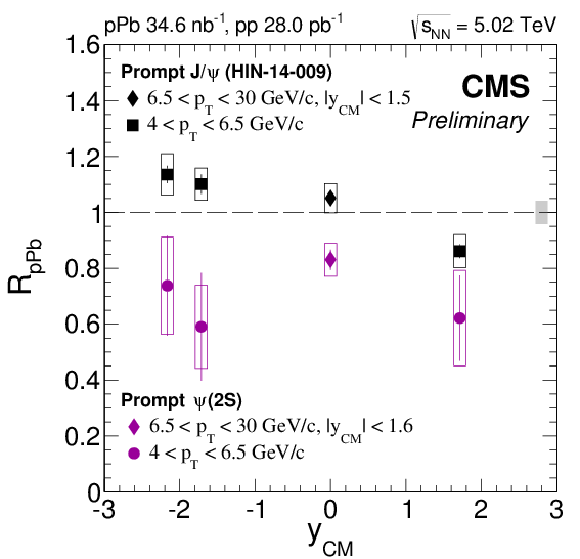
png pdf |
Figure 2-a:
Rapidity dependence of RpPb for prompt ψ(2S) in the 4 <pT< 6.5 GeV/c range. The error bars represent the statistical uncertainties, and the boxes show the quadratic sum of systematic uncertainties. The fully correlated global uncertainty of 4.2% is displayed as a grey box arround RpPb= 1. |
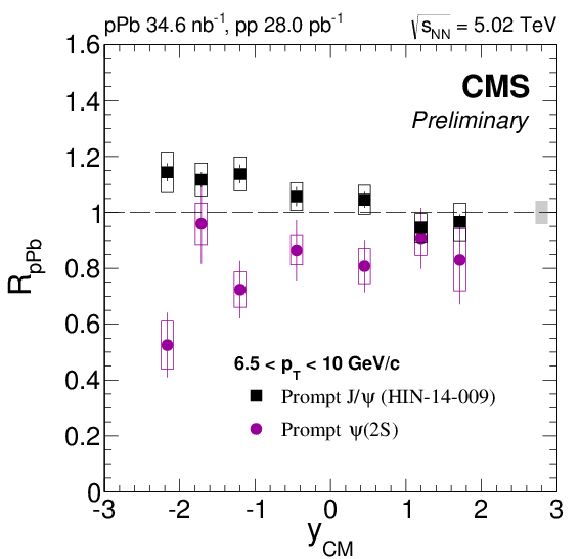
png pdf |
Figure 2-b:
Rapidity dependence of RpPb for prompt ψ(2S) in the 6.6 <pT< 10 GeV/c range. The error bars represent the statistical uncertainties, and the boxes show the quadratic sum of systematic uncertainties. The fully correlated global uncertainty of 4.2% is displayed as a grey box arround RpPb= 1. |
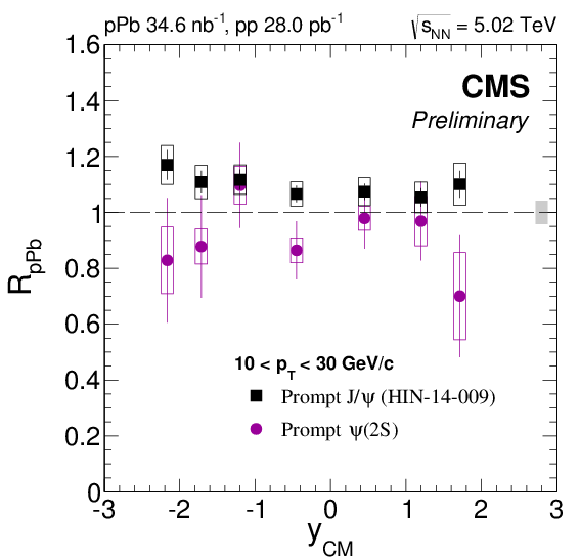
png pdf |
Figure 2-c:
Rapidity dependence of RpPb for prompt ψ(2S) in the 10 <pT< 30 GeV/c range. The error bars represent the statistical uncertainties, and the boxes show the quadratic sum of systematic uncertainties. The fully correlated global uncertainty of 4.2% is displayed as a grey box arround RpPb= 1. |
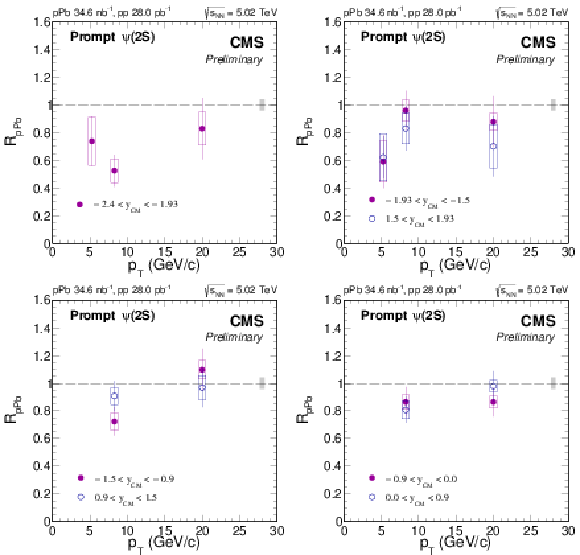
png pdf |
Figure 3:
Transverse momentum pT dependence of RpPb for prompt ψ(2S) in four rapidity ranges. The error bars represent the statistical uncertainties, and the shaded boxes show the quadratic sum of systematic uncertainties. The fully correlated global uncertainty of 4.2% is displayed as a grey box arround RpPb = 1. |
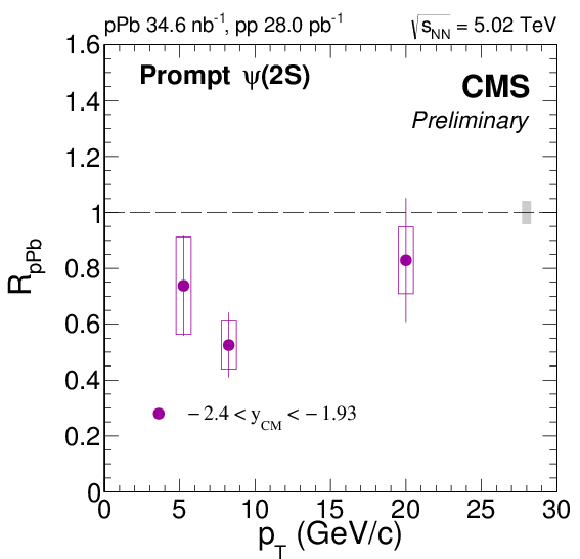
png pdf |
Figure 3-a:
Transverse momentum pT dependence of RpPb for prompt ψ(2S) in rapidity range −2.4<yCM<−1.93. The error bars represent the statistical uncertainties, and the shaded boxes show the quadratic sum of systematic uncertainties. The fully correlated global uncertainty of 4.2% is displayed as a grey box arround RpPb = 1. |

png pdf |
Figure 3-b:
Transverse momentum pT dependence of RpPb for prompt ψ(2S) in rapidity ranges −1.93<yCM<−1.5 and 1.5<yCM<1.93. The error bars represent the statistical uncertainties, and the shaded boxes show the quadratic sum of systematic uncertainties. The fully correlated global uncertainty of 4.2% is displayed as a grey box arround RpPb = 1. |

png pdf |
Figure 3-c:
Transverse momentum pT dependence of RpPb for prompt ψ(2S) in rapidity ranges −1.5<yCM<−0.9 and 0.9<yCM<1.5. The error bars represent the statistical uncertainties, and the shaded boxes show the quadratic sum of systematic uncertainties. The fully correlated global uncertainty of 4.2% is displayed as a grey box arround RpPb = 1. |

png pdf |
Figure 3-d:
Transverse momentum pT dependence of RpPb for prompt ψ(2S) in rapidity ranges −0.9<yCM<0 and 0<yCM<0.9. The error bars represent the statistical uncertainties, and the shaded boxes show the quadratic sum of systematic uncertainties. The fully correlated global uncertainty of 4.2% is displayed as a grey box arround RpPb = 1. |
| Summary |
| The pPb and pp collision data at √sNN= 5.02 TeV taken by the CMS detector are used to investigate the production of prompt ψ(2S). The results are based on pPb and pp data samples collected by CMS at the LHC corresponding to an integrated luminosity of 34.6 nb−1 and 28.0 pb−1 respectively. The nuclear modification factor of prompt ψ(2S) is determined in the kinematic interval 4 <pT< 30 GeV/c and −2.4<yCM< 1.93, and compared to the RpPb of prompt J/ψ. The suppression is more pronounced in the region of negative rapidity and at pT< 10 GeV/c. The RpPb of ψ(2S) is also found to be smaller to that of the J/ψ measured in Ref. [18], over the whole kinematic range studied. The different nuclear dependence of J/ψ and ψ(2S) reported here cannot be attributed to nPDF or coherent energy loss effects which predict a similar suppression in both channels. It may however be consistent with the picture of final state inelastic interaction of ψ(2S) mesons in the medium produced in pPb collisions at √sNN= 5 TeV. |
| References | ||||
| 1 | T. Matsui and H. Satz | J/ψ Suppression by Quark-Gluon Plasma Formation | PLB 178 (1986) 416 | |
| 2 | NA38 Collaboration | The Production of J/ψ in 200-GeV/nucleon Oxygen Uranium Interactions | PLB 220 (1989) 471--478 | |
| 3 | NA50 Collaboration | Anomalous J/ψ suppression in Pb-Pb interactions at 158 GeV/c per nucleon | PLB 410 (1997) 337--343 | |
| 4 | PHENIX Collaboration | J/ψ production versus centrality, transverse momentum, and rapidity in AuAu collisions at √sNN= 200 GeV | PRL 98 (2007) 232301 | nucl-ex/0611020 |
| 5 | PHENIX Collaboration | J/ψ suppression at forward rapidity in Au+Au collisions at √sNN= 200 GeV | PRC 84 (2011) 054912 | 1103.6269 |
| 6 | ALICE Collaboration | Centrality, rapidity and transverse momentum dependence of J/ψ suppression in Pb-Pb collisions at √sNN= 2.76 TeV | PLB 734 (2014) 314--327 | 1311.0214 |
| 7 | CMS Collaboration | Indications of suppression of excited Υ states in PbPb collisions at √SNN = 2.76 TeV | PRL 107 (2011) 052302 | CMS-HIN-11-007 1105.4894 |
| 8 | CMS Collaboration | Observation of sequential Upsilon suppression in PbPb collisions | PRL 109 (2012) 222301 | CMS-HIN-11-011 1208.2826 |
| 9 | CMS Collaboration | Suppression of non-prompt J/ψ, prompt J/ψ, and Υ(1S) in PbPb collisions at √sNN= 2.76 TeV | JHEP 05 (2012) 063 | CMS-HIN-10-006 1201.5069 |
| 10 | V. Kumar, P. Shukla, and R. Vogt | Quarkonia suppression in PbPb collisions at √sNN= 2.76 TeV | PRC92 (2015), no. 2, 024908 | 1410.3299 |
| 11 | E. Ferreiro, F. Fleuret, J. Lansberg, and A. Rakotozafindrabe | Impact of the Nuclear Modification of the Gluon Densities on J/ψ production in pPb collisions at √sNN= 5 TeV | PRC 88 (2013) 047901 | 1305.4569 |
| 12 | R. Vogt | Shadowing effects on J/ψ and Υ production at energies available at the CERN Large Hadron Collider | PRC 92 (2015) 034909 | 1507.04418 |
| 13 | F. Arleo and S. Peign\'e | J/ψ suppression in p-A collisions from parton energy loss in cold QCD matter | PRL 109 (2012) 122301 | 1204.4609 |
| 14 | F. Arleo, R. Kolevatov, S. Peign\'e, and M. Rustamova | Centrality and pT dependence of J/ψ suppression in proton-nucleus collisions from parton energy loss | JHEP 05 (2013) 155 | 1304.0901 |
| 15 | ALICE Collaboration | J/ψ production and nuclear effects in p-Pb collisions at √sNN= 5.02 TeV | JHEP 02 (2014) 073 | 1308.6726 |
| 16 | ALICE Collaboration | Rapidity and transverse-momentum dependence of the inclusive J/ψ nuclear modification factor in p-Pb collisions at √sNN= 5.02 TeV | JHEP 06 (2015) 055 | 1503.07179 |
| 17 | ATLAS Collaboration | Measurement of differential J/ψ production cross sections and forward-backward ratios in p+Pb collisions with the ATLAS detector | PRC 92 (2015) 034904 | 1505.08141 |
| 18 | CMS Collaboration | J/ψ production in p Pb collisions | To be submitted to EPJC(2017) | |
| 19 | LHCb Collaboration | Study of J/ψ production and cold nuclear matter effects in pPb collisions at √sNN= 5 TeV | JHEP 02 (2014) 072 | 1308.6729 |
| 20 | ALICE Collaboration | Production of inclusive Υ(1S) and Υ(2S) in p-Pb collisions at √sNN= 5.02 TeV | PLB 740 (2015) 105--117 | 1410.2234 |
| 21 | LHCb Collaboration | Study of Υ production and cold nuclear matter effects in pPb collisions at √sNN= 5 TeV | JHEP 07 (2014) 094 | 1405.5152 |
| 22 | ALICE Collaboration | Suppression of ψ(2S) production in p-Pb collisions at √sNN= 5.02 TeV | JHEP 12 (2014) 073 | 1405.3796 |
| 23 | LHCb Collaboration | Study of ψ(2S) production and cold nuclear matter effects in pPb collisions at √sNN= 5 TeV | JHEP 03 (2016) 133 | 1601.07878 |
| 24 | E. G. Ferreiro | Excited charmonium suppression in proton–nucleus collisions as a consequence of comovers | PLB 749 (2015) 98--103 | 1411.0549 |
| 25 | CMS Collaboration | Event activity dependence of Y(nS) production in √sNN= 5.02 TeV pPb and √s= 2.76 TeV pp collisions | JHEP 04 (2014) 103 | CMS-HIN-13-003 1312.6300 |
| 26 | CMS Collaboration | The CMS experiment at the CERN LHC | JINST 3 (2008) S08004 | CMS-00-001 |
| 27 | CMS Collaboration | Performance of CMS muon reconstruction in pp collision events at √s= 7 TeV | JINST 7 (2012) P10002 | CMS-MUO-10-004 1206.4071 |
| 28 | CMS Collaboration | Measurement of Prompt ψ′ to J/ψ Yield Ratios in Pb-Pb and p-p Collisions at √sNN= 2.76 ��TeV | PRL 113 (2014), no. 26, 262301 | CMS-HIN-12-007 1410.1804 |
| 29 | CMS Collaboration | Relative modification of prompt ψ′ and J/ψ yields from pp to PbPb collisions at √sNN= 5.02 TeV | Submitted to: PRL (2016) | CMS-HIN-16-004 1611.01438 |
| 30 | W. Verkerke and D. P. Kirkby | The RooFit toolkit for data modeling | eConf C0303241 (2003) MOLT007, [,186(2003)] | physics/0306116 |
| 31 | Particle Data Group, J. Beringer et al. | Review of Particle Physics | PRD 86 (2012) 010001 | |
| 32 | ALEPH Collaboration | Measurement of the ¯B0 and B− meson lifetimes | PLB 307 (1993) 194 | |
| 33 | ALEPH Collaboration | Errata: Measurement of the ¯B0 and B− meson lifetimes | PLB 325 (1994) 537 | |
| 34 | T. Sjostrand, S. Mrenna, and P. Skands | PYTHIA 6.4 physics and manual | JHEP 05 (2006) 026 | hep-ph/0603175 |
| 35 | T. Sjostrand, S. Mrenna, and P. Skands | A Brief Introduction to PYTHIA 8.1 | CPC 178 (2008) 852--867 | 0710.3820 |
| 36 | CMS Collaboration | Measurement of the prompt J/ψ and ψ′ polarizations in pp collisions at √s= 7 TeV | PLB 727 (2013) 381 | CMS-BPH-13-003 1307.6070 |
| 37 | E. Barberio, B. van Eijk, and Z. Was | PHOTOS: A Universal Monte Carlo for QED radiative corrections in decays | CPC 66 (1991) 115--128 | |
| 38 | GEANT4 Collaboration | GEANT4: A Simulation toolkit | NIMA506 (2003) 250--303 | |
| 39 | CMS Collaboration | Measurements of Inclusive W and Z Cross Sections in pp Collisions at √s= 7 TeV | JHEP 01 (2011) 080 | CMS-EWK-10-002 1012.2466 |

|
Compact Muon Solenoid LHC, CERN |

|

|

|

|

|

|